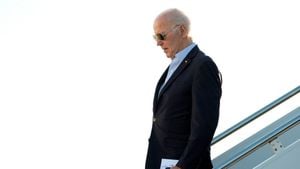Universities across Texas are hitting the brakes on tuition hikes, bringing relief to students and families amid rising inflation woes. This move came after Governor Greg Abbott took to X (formerly Twitter) on Wednesday, announcing his opposition to any increases for the 2025-2026 and 2026-2027 academic years. Abbott had previously backed legislation to keep tuition steady through the 2023-2024 and 2024-2025 school years, asserting, "Our universities must take every step possible to ease the financial burden on our students & their families." The governor's office has engaged closely with the Board of Regents across Texas’s public university systems, emphasizing the state’s investment efforts to bolster higher education.
Simultaneously, higher education institutions across the United States are grappling with a complex challenge: balancing the rising costs of tuition against the backdrop of increasing scrutiny over the value of college degrees. With student debt hitting staggering levels and many students questioning the necessity of traditional education, the pressures are mounting on universities to demonstrate how they provide value for the financial investment.
Despite this troubling sentiment circulating around higher education, California Polytechnic State University (Cal Poly) is bucking the trend. For the 2024-2025 academic year, Cal Poly reported nearly 79,000 applications, making admission even more competitive. This spike raises eyebrows—why is Cal Poly still appealing at a time when other institutions may struggle to attract students? Students and educators attribute Cal Poly's success to its unique educational approach, notorious for its hands-on learning philosophy encapsulated in the motto "Learn by Doing." This model not only enhances student engagement but directly equips them with practical skills relevant to today’s job market.
Such experiential learning nurtures job-ready graduates. Cal Poly alumna Kathleen Aranjo recalls her time at the university, stating, "The ‘Learn by Doing’ motto played out immediately for me... the classes prepared me to step directly from school to working with clients." That self-assured readiness makes Cal Poly graduates particularly attractive to employers.
On the flip side, Utah’s public colleges might be dealing with budget cuts as legislators seek to address perceived inefficiencies within the higher education system. House Speaker Mike Schultz is already pushing for reforms, focusing on financial restraints and potentially lowering costs for students without passing those expenses onto them via tuition hikes. He considers it imperative to assess the allocation of state funds to public colleges and whether they're yielding desired educational outcomes. Schultz carries concerns over rising administrative costs, which he claims have increased sharply at some institutions compared to others.
Higher education funding has been under scrutiny lately; even though investment has grown significantly—from $1.59 billion to $3.01 billion over ten years—so has enrollment from 167,317 to 207,005. “There’s not been equal budget growth compared to the increased student population,” said Rep. Karen Peterson, emphasizing the pressing need to reevaluate higher education funding procedures and whether they're aligned with the economic needs of the state.
The looming narrative of budgetary adjustments and the push for reform highlights the broader challenges within the sphere of public education. With increasing costs calling the attention of students, families, and education leaders alike, how will institutions continue to evolve, uphold quality education standards, and maintain accessibility? While Cal Poly serves as a beacon of hope amid rising tuition debates, other institutions face tighter scrutiny from lawmakers intent on addressing inefficiencies, ensuring the value of higher education remains intact.
Cal Poly's enduring appeal—anchored by surveying hands-on learning, favorable location, and vibrant campus culture—creates pathways for students to explore beyond traditional metrics of education. The idyllic Central Coast setting, featuring mountains and ocean access, offers students the full college experience they crave, running parallel to exciting academic challenges.
Even as the general sentiment around the value of college fluctuates, with many seeking alternative education routes like self-directed learning, Cal Poly’s ability to attract applicants suggests not only the power of place but also purpose. Students are drawn toward meaningful interactions and experiences they can't land elsewhere. This convergence of thoughtful instruction and lifestyle stands as testimony to Cal Poly's role as more than just another higher education institution.
Meanwhile, as Utah's lawmakers aim to address financial concerns relating to higher education, they also realize they must tread carefully. Any immediate cuts must avoid negatively impacting students’ educational experiences and long-term workforce potentials. Budget discussions will likely remain at the forefront as the state weighs the economic impact of its universities against the necessity of solidifying its higher education system.
Budgetary challenges and educational value will remain topics of conversation across state lines. While Texas retains its commitment to no tuition increases, Utah’s potential budget cuts require scrutiny over their implications for accessible education.
Both states showcase the impact of heightened focus on operational costs against the need for student-centered educational reforms. Will these institutions yield the desired outcomes for their communities? How will each state navigate the educational waters swirling with challenges? Only time will tell—but the coming months promise to be pivotal for students and institutions alike.
The overarching echo of affordability resonates within the sector, with both Texas pledging to maintain tuition steadiness and Utah’s legislative endeavors sharpening at the need for efficiencies. Navigators of higher education will be tasked with mapping new consumer paths ensuring the future workforce is as equipped and prepared as possible.



